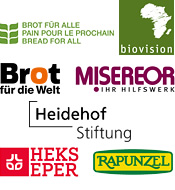Health: Food or cause of illness?
Food safety regulations and laws forbidding the contamination of drinking water are among the oldest laws in the world. The IAASTD warns that food safety in developing and industrialised countries is increasingly threatened by new and persistent dangers. Microbial food contamination from bacteria (e.g. E. coli, staphylococcus, salmonellae), fungi, viruses or parasites is currently topping the list of health hazards, often leading to acute symptoms. Food scandals are no more than the tip of the iceberg."As food passes over extended periods of time through the food production, processing, storage and distribution chain, control has become difficult, increasing the risks of exposing food to intentional, undetected or involuntary contamination or adulteration. The use of pesticides and fertilizers, the use of hormones in meat production, large-scale livestock farming, and the use of various additives by food processing industries are among the food safety concerns that are associated with the globalized food system (GFS). In developing countries, GFS safety concerns are compounded by rampant poverty negatively influencing policy compliance and poor infrastructure for enforcement of food control systems." (Global, p. 111)Exposure to or poisoning from pesticides, heavy metals and other residues, such as dioxins, polychlorinated biphenyls (PCB) or synthetic hormones, often goes unnoticed due to the length of time it takes for symptoms to develop. If chronic symptoms appear subsequently, it is often difficult to identify the exact causes in individual cases. This also applies to the effects and the interaction of a large number of new chemical substances and food additives to which consumers are exposed today. New disorders and conditions such as allergies, hyperactivity and certain types of cancer are on the rise.
The increasingly expensive and complex technical safety standards, established in response to the growing health hazards of the global food system, bring with them a number of negative consequences. Small-scale producers are unable to comply with the requirements of sophisticated traceability and labelling systems, which were created by industrialised nations and international corporations to monitor food from farm to fork. These standards, for example the guidelines of the Codex Alimentarius established by FAO and WHO or the sanitary and phytosanitary measures (SPS) of the World Trade Organisation have the effect of concentrating the market. In industrialised countries, they degrade traditional forms of food production and thus food quality. Developing countries are often unable to bear the cost of such hygiene standards and monitoring systems. As a result, they are commonly applied exclusively to export goods, while simple and effective local security measures are not introduced.
Agriculture – a dangerous sector
Agriculture, apart from mining and construction, is one of the most hazardous sectors to work in. Of the millions of accidents occurring in agriculture, at least 170,000 agricultural workers die in work-related accidents each year. The main causes of accidents are farm machinery and poisoning by pesticides or other agrochemicals: however, physical overload, noise, dust, allergies and infectious diseases transmitted between animals and humans also need to be taken into account. The International Labour Organisation estimates that 59% of all child labourers work in agriculture, amounting to over 98 million girls and boys worldwide. The number of unreported cases is particularly high in this sector.
New and persistent dangers
Infectious diseases transmitted between animals and humans rank among the most serious health risks in agriculture. Certain methods of cultivation favour outbreaks of these zoonotic diseases. Irrigation methods, for example, play a substantial role in the spread of malaria or other insect-borne diseases. Most victims of these diseases are women and children in rural areas, who do not have the means to prevent or treat such diseases. Both private and public research frequently focuses on those illnesses which primarily affect wealthier populations in cities and industrialised countries.
An additional danger to human health is the increasing antimicrobial resistance arising from the use of antibiotics in industrialised farming systems. As long ago as 1997, the WHO warned against the sub-therapeutic use of antibiotics in livestock production, as the development of resistant strains of bacteria make diseases untreatable with antibiotics. In a new report released in 2012, the WHO reiterated its warning about the growing threat of antimicrobial resistance."There are currently 204 infectious diseases known to be spreading in both high- and low-income countries. 75% of these are zoonotic, meaning they are transmitted between animals and humans. These diseases are directly threatening human health and posing an indirect threat to rural incomes and livelihoods due to resultant trade restrictions. The transmission of mad cow disease (BSE) and avian influenza (H5N1) are two high-profile examples of diseases that can be linked to low standards in the animal feed industry." (Global, p. 198)
The IAASTD contends that agriculture and nutrition are the foundations of human health. At the same time, they are a major cause of disease in both rich and poor countries. Healthy and sustainable diets, safe methods of food production and sustainable agriculture could prevent suffering and premature death for millions of people. "Agricultural knowledge, science and technology has focused on adding financial value to basic foodstuffs (e.g., using potatoes to produce a wide range of snack foods). This has resulted in cheap, processed food products with low nutrient density (high in fat, refined sugars and salt), and that have a long shelf life. Increased consumption of these food products that are replacing more varied, traditional diets, is contributing to increased rates of obesity and diet-related chronic disease worldwide." (Synthesis, p. 54) These are also decisive factors for a solid economic upturn in developing countries and an effective way to reduce escalating costs in the healthcare systems for industrialised countries. One of the key messages of the IAASTD is that sustainable and healthy diets can only be achieved where consumption (demand) and production are developed together instead of separately. This message is no longer a contentious issue from a scientific point of view, but putting it into practice is inhibited by powerful economic interests.








